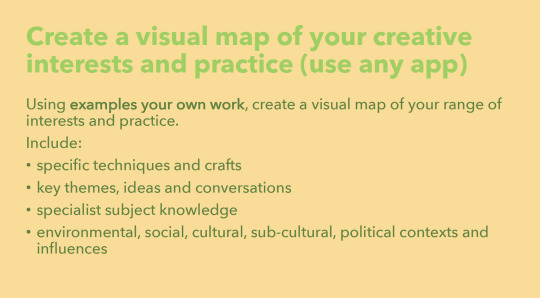Don't wanna be here? Send us removal request.
Text
POSTER IDEAS/ EXPERIMENTS
My process in creating my A2 poster, looking at the placement of the objects, image treatment, and colours.
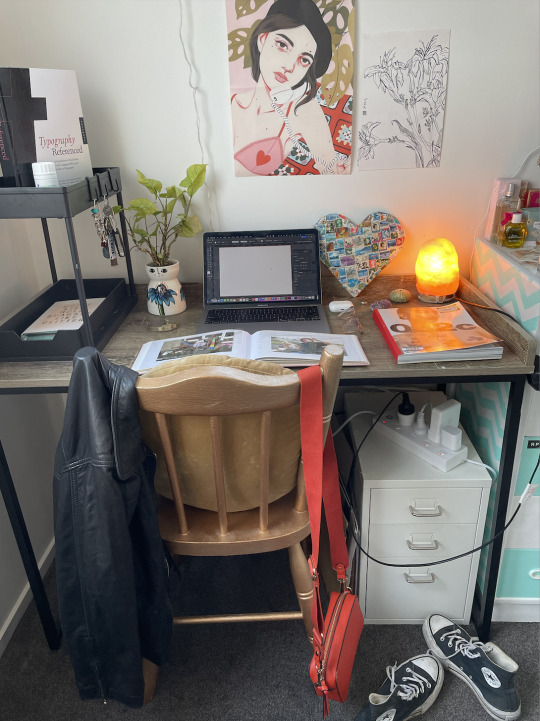

First I had the idea to photograph all of my objects together, but wanted to display them in a more casual way, to show that they are simply a part of my day-to-day life. I thought I could effectively convey this by situating them on or around my desk, as though they are meant to be there. I also had another idea for a completely different approach, still using photographs of the objects, but applying surreal editing effects, using inverted imagery (as previously discussed in my formative. I thought the outcome of this was interesting, but wasn't really conveying what I had in mind. I also played around with combining the two images/ideas, by editing the second image into the computer screen on my laptop in the first image, following a similar concept to the Dorset effect.
(The Droste effect describes a specific type of recursive picture in which a smaller version of the larger image is featured within the larger image. Another term for this surreal photography effect is mise en abyme, which refers to the practice of inserting a replica of an image within itself.)
I decided that this wasn't working, and wanted to find a simpler way to portray my objects. The technique of image trace in illustrator fascinates me, as it can turn a photograph into a simple illustration/outlines, making it feel more human, and giving them a rugged edge. I played around with different colours and patterns, before landing on my final outcome.
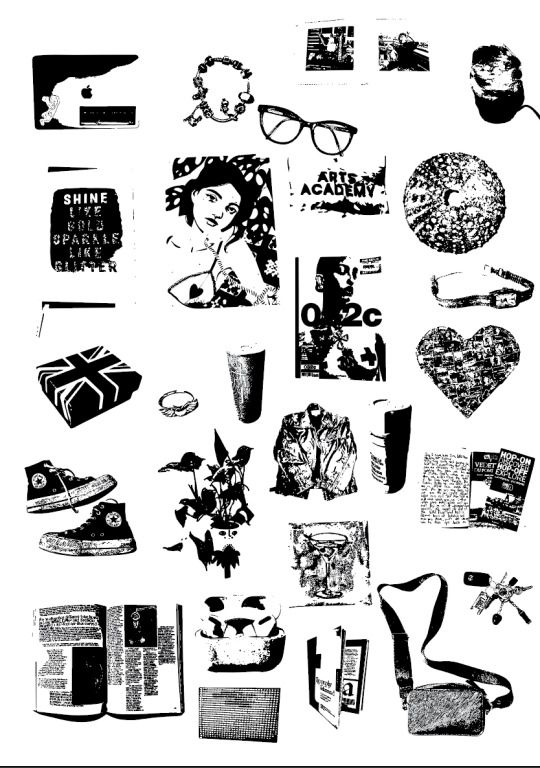

My current working poster draft. I think this is the final outcome/ approach I would like to take. I have created a checkered pattern, alternating the colours between the images and the squares. I think this is a unique way to display my elements, giving them each separate boxes to ensure they stand out equally. Stripping back the original colours and portraying them through one colour only, gives a raw feel to them, displaying only their main forms/shapes, and giving an element of mystery to each. I am yet to complete my written inventory for each element but am in the process of doing so.
0 notes
Text



Feedback from my Formative Presentation on the 3 C’s
Key Take Aways:
- I made clear connections between my design influences and my own work.
- good in depth, detailed inquiry into local and international creatives.
- experimental with my own design in response to inspirations.
- good unpacking on Miro Board, shows my process in researching inspirations and exploring connections in my own work. (interpersonal, interdisciplinary, and inter style).
- I need to delve deeper into the ‘why’ - reasoning behind my research. I need to articulate more of my own work in connection to my influences (like I did with Andrew Prokos).
- social and environmental impacts are a strong theme throughout my work and inspirations.
- key ideas + environmental context shown in my own work, very colourful, experimental, fun and playful. Incorporates digital and analogue, modern and classic design.
- need to post more on my Tumblr page, go into detail to describe my research and creative process.
0 notes
Text
My Week 6 Formative Presentation - The Three C's
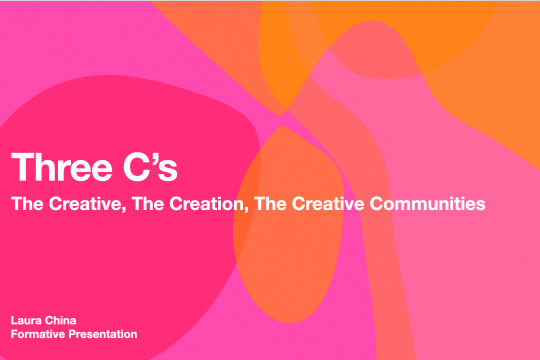





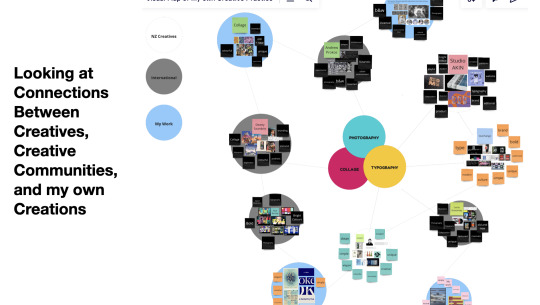




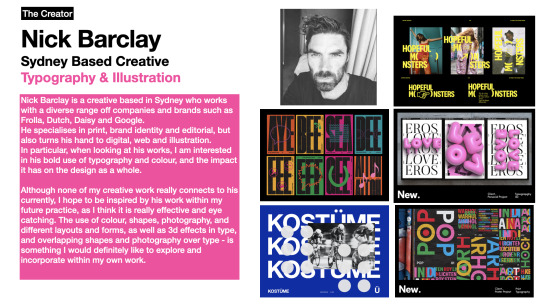

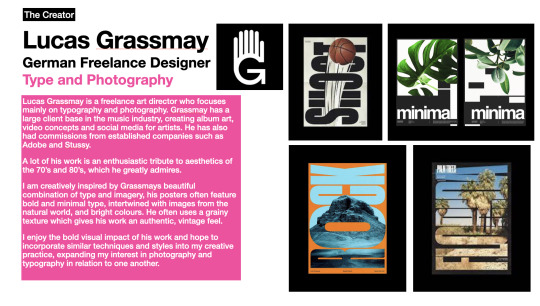



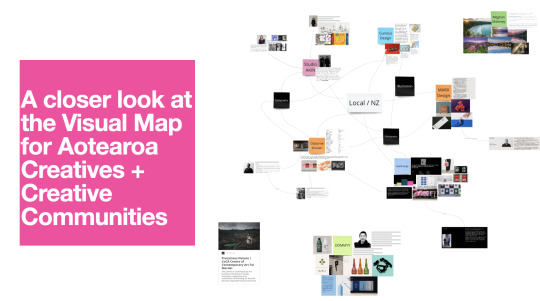

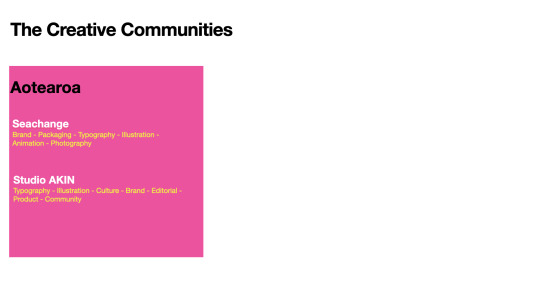


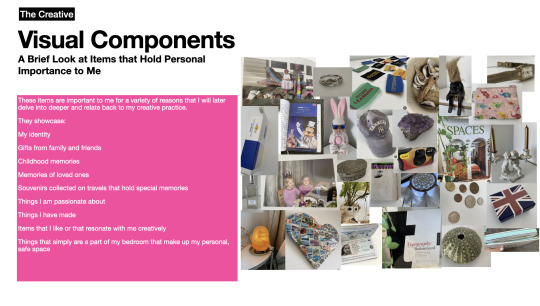

0 notes
Text
My 20 Elements
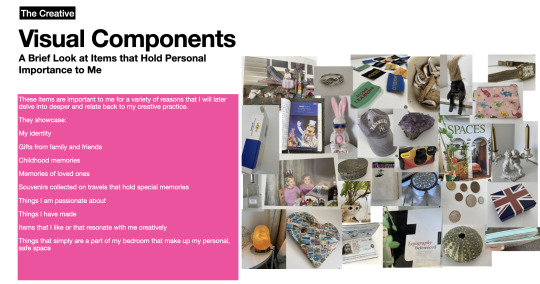
These are some of the quick observations I have gathered within my range of items that I have selected that have significance to me personally and creatively. As I have gone through and analysed each object, I have realised that many of them don't have deep enough meaning to me, and I was simply looking at what I looked most on the surface ( the visual appearance of the objects, and the immediate meaning). Due to this, I have decided to change many of my previously selected objects, and thought deeply about the objects I have chosen. I still need to take photos of my new items to then edit and assemble into the collage I am planning to create.
List of new objects I have selected:
Vintage Seiko watch from my grandmother - looking at its historical and personal importance to me and my ancestry.
Pandora Charm Bracelet
Plant in Face Vase
Print of Girl on Phone
Salt Lamp
Teva ADHD Medication
Glasses
Childhood Travel Journal
Drivers License
032C Magazine
Green Sea Urchin Shell
Heart Ring
Amethyst Crystal
Post Stamp Paper Cache Heart
Union Jack Jewellery Box
Childhood Photo Album
Koala Stuffed Animal
Intermediate Arts Academy Badge
Black Converse High Top Sneakers
Macbook laptop
Why have I chosen them:
I have begun to write about my chose objects to create my inventory. Looking at my in-depth observations and thoughts about the objects which I will need to summarise when creating the poster inventory.


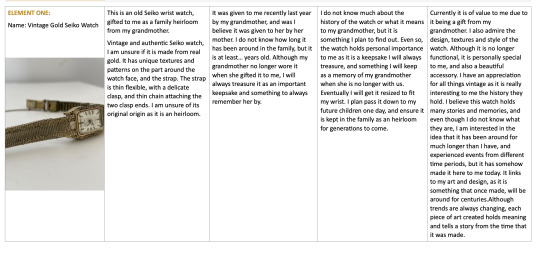

2 notes
·
View notes
Text
Task 1 - Response to "Materialising Pedagogies"
Materialising Pedagogies - Dr Barbara Bolt
What is material thinking?
A specific way of understanding the world, in a way that requires theorising out of practice. Material thinking offers us a way of considering the relations and connections that take place within the process of making/ producing a final outcome. It involves a particular responsiveness to the intelligence of materials and processes in practice. In simpler terms, it is the method of making connections within our creative process and applying these to the making of the project - the meaning behind what we did and why we did it.
2. Choose one of the creatives from the lecture and describe their material thinking?
Cecelia's presentation of her own creative work that she showed us, was a collage like video of a young girl navigating the city (leaving the house, catching the bus and going about her day). She is the only aspect of life in the video, moving in comparison to the city and people who are still images in the background. Her material thinking looked at two different groups of people in the world (adults, and adolescence), and the struggles that youth have growing up and the impact it has on them mentally, in that they can often feel disconnected and misunderstood in society and around people older than them, but that it is important to open up and share their thoughts with loved ones.
How can material thinking be seen through your own work?
Thinking about why I did what I did and the meaning behind it, as I am going about the process. Often I will create my work and then look at creating meaning from the outcome itself, rather than going through the process and researching thoroughly beforehand.
How would you reference the reading from today?
Bolt, B. (n.d.). Materialising pedagogies. University of Melbourne, AU. <[email protected]>
0 notes
Text
SDL - Curators of Pohewa Pahewa Exhibition

Desna Whaana-Schollum
Desna Whaanga-Schollum (nō Rongomaiwahine, Ngāti Kahungunu, Pāhauwera) is Co-Chair of Māori and Indigenous design network Ngā Aho. Desna’s work is connected through the exploration and articulation of cultural identity. Projects see her collaborating with a wide variety of communities, business and design professionals, artists and academics to achieve results which effect change in people, practice and place. Desna is actively involved in Māori identity design, discourse and stakeholder engagement in Aotearoa, via design consultancy, research, exhibitions, wānanga, speaking engagements and governance roles.
Tyrone Ohia
Tyrone Ohia was born in Tauranga, raised in Whanganui, and is founder and creative director of Extended Whānau – an award winning design studio based in Tāmaki Makaurau.
Driven by visual storytelling, the studio works on a wide range of projects, with a wide range of collaborators, with the aim of elevating and promoting all aspects of te ao Māori through design.
Graham Tipene
Johnson Witehira
Zoe Black
0 notes
Text
Week 5 Lecture
The Creative Communities
Design Research - the group of ideas you put together when creating your work.
Research Paradigm - the reasons behind your method (the group of ideas that informs your work.
"The philosophical intent or underlying theoretical framework and motivation ...
Your Creative Work
Method - how it was carried out
Methodology -
Positivism
research recognises only that which is..
Interpretivism
Research is inherently shaped by the researcher, who brings their own subjective view of observed phenomenon...
Indigenous (The Kaimahi)
process is important for the final outcome.
relationships formed.
Connecting and sharing
researches worldview the informs the inquiry.
abundance, relationships, spiritual, decorative.
Post Critical Researcher (The Forager)
experimental, innovative.
David Sinfield
Connecting Community:
Artistic echoes of a forgotten small-town community.
Strike: A Poem Film
Talita Toluta'u
Tatiana Tavares
draws on her cultural heritage, and religious beliefs.
Marcos Steagall and Maree Sheehan
Cecelia
Faumuina
Methodology
Design Research
Tell us about you, your work and the communities you are a part of or want to be a part of.
Tutorial
Formative Assessment 01
Due next week - 22 August
0 notes
Text
20 Items for Visual Research Inventory - continued










0 notes
Text
Week 4 SDL
Documenting 20 objects - testing creative strategies for visual research inventory systems.
At home, I took some photos on my camera of an array of items I own that have significant personal importance to me, are mementos from the past, or simply things that I like and find interesting. Whilst I haven’t downloaded these images from my camera yet, I also took some photos and videos on my iphone.










0 notes
Text

Visual Mapping - Who's who in the Zoo?
As an in-class exercise, we collaboratively created a visual map to connect related NZ creatives. Linking them in ways and describing how and why they are connected.
I particularly looked at the connection between Karen Walker and Osborne Shiwan, who designed a brand identity for her. As well as looking at the Co-Owners and their individual and collaborative work in their brands such as SeaChange, Studio AKIN, MARX Design etc.
0 notes
Text
Week 4 Notes

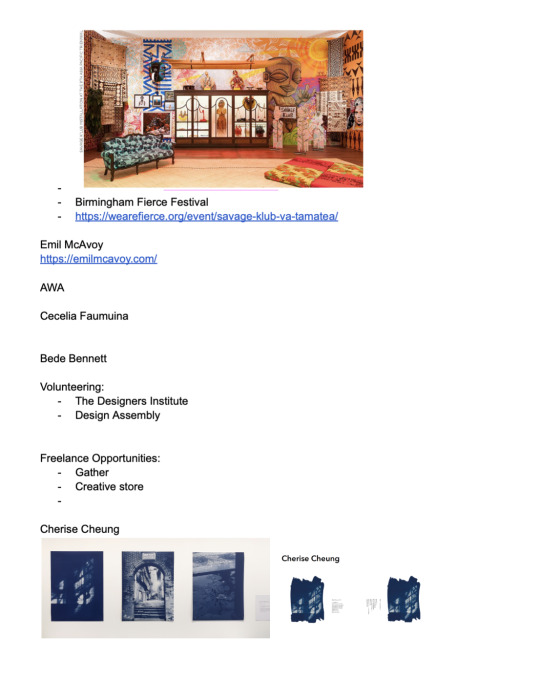


Links:
Natalie Robertson
Rosanna Raymond
Emil McAvoy
The Centre for Design Research
0 notes
Text





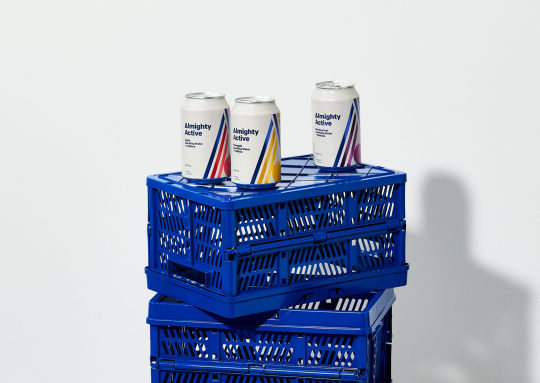

Ryan Marx
Ryan Marx is the founder of successful NZ Graphic Design Studio, Marx Design.
Marx specialises in all elements of design, packaging, brand identity and communications, guided by our innate curiosity and love of strategic thinking. The brand transforms commercial challenges into creative opportunities. Using insights and design knowledge to deepen the resonance and relevance of brands, Marx Design works with businesses looking for a different take on their brand.
0 notes
Text
Week 3 Tutorial
'Locating your creative practice, finding your creative voice'.
Part 1: Critical review
name
Tumblr URL
title, sub title
abstract
the creative
the creation
the creative communities
conclusion: key insights or breakthroughs in understanding and defining you practice led design-research.
How to find credible sources
Find 20 sources through a range of library databases.
Look for:
specific techniques and crafts
key themes, ideas and conversations
specialist subject knowledge
creatives working in the environmental, social, cultural, sub-cultural, and political contexts
0 notes






















